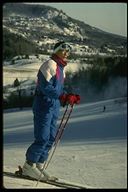
.Gym Based Ski Fitness.

Through my personal experience skiing, and reading related articles on the subject I have some suggestions concerning the exercise programme you could undertake in your gym.
| MUSCLE GROUP | Involvement in Skiing | Exercise Suggestions |
|---|---|---|
| Tibialis Anterior | Tibialis Anterior is used in the ski boot to pull your body forward when you feel that you are falling backwards. | Low Pulley Dorsiflexion; Rowing with your feet strapped in firmly so on the recovery stroke you recruit Tib Ant. |
| Soleus | As most skiing is carried out with the knees bent, Gastronemius can't effectively operate. Soleus is used often to stop you from falling forwards. | Seated Calf Raises. |
| Quadriceps | The quads are used constantly in downhill skiing isometrically, eccentrically and concentrically. To preserve the integrity of the knee, the quads should be strengthened. | ISOLATED: Leg Extension. COMPOUND: Squats, Leg Press, Lunges, and Step-ups. |
| Gluteus Maximus and the Hamstrings | The flexion at the hip in skiing is maintained by Glut Max and the Hammies working through both Isotonic contraction modes, and Isometrically to maintain stability and absorb shock. | ISOLATED: Butt Balster, Leg Curl (both standing and lying) COMPOUND: Squats, Leg Press, Lunges and Step-ups. |
| Hip Adductors | The 3 Adductors are used (especially in beginners) to control the width of your ski track, and strength here is very important. | Low pulley Adduction, Lower leg raises, Lying Bench adduction, Seated hip Adduction machines, and the standing multi-hip machines. |
| Hip Abductors | The 2 Abductors are excellent hip stabilisers, and assist in some steering manoeuvres. | Low Pulley Abduction, Side leg raises, Seated Hip Abduction machines and the standing multi-hip machines. |
| Hip Rotators (Internal and External) | The hip rotators are a very important muscle group for beginners and are still used by more advanced skiers. They are the fine steering control muscles. | Low Pulley Hip Rotation. Isometric hip rotation strengthening exercises in a doorway. |
| MUSCLE GROUP | Involvement in Skiing | Exercise Suggestions |
|---|---|---|
| Erector Spinae | Because of the trunk flexion stance that most people undertake when skiing downhill, the lower back muscles are working overtime, so specific strengthening will help reduce back ache. | Back contractions,Alternate arm-leg raises, back extension on the roman chair and the 45 degree back extension. |
| Rectus Abdominis and Obliques | By strengthening the abdominals we can increase intra-abdominal pressure and support the spine from the front. Keeping these postural muscles strong is important. | Abdominal Curls, Crunches, Oblique crunches, Cross-over reverse crunches, Opposite crunches, Hip raises. |
| Latissimus Dorsi | The Lats are used for the strong poling needed to travel over smooth ground or for moving uphill. Strengthening them in ski specific exercises such as low pulley row is needed. | Lat Pulldown, Reverse Pulldown, Low Pulley row, Dumbbell Single are bench row, T-bar row, and bent over row. |
| Triceps brachii | The Triceps are used in the final phase of the poling pushoff as the arm is extended behind the body, and through forceful elbow extension a final push is applied before recovery for the next stroke. | High pulley Tricep pushdown, Dumbbell Tricep kickbacks, Lying Tricep extension ('the skull crusher') French Press. |
| Biceps brachii | In conjunction with the lats, the biceps assist in forward movement by doing some elbow flexion and while contracting, stabilise the shoulder joint through force applied by the long head of Biceps through the bicipital groove. | Reverse Pulldown, Dumbbell Concentration curls, Barbell bicep Curls, Hammer curls, Low Pulley row. |
When doing your selection of the above muscular conditioning exercises, you need to remember two things. You need strength in movement related ski muscles like the hip rotators, and endurance in the postural muscles. So do a MSS ( multiple set system ) for strength ( low reps, heavy resistance ) and a lighter weight and increased reps for the muscular endurance.
Cardiovascular fitness is necessary in skiing, not so much for performance,
but more for the central body endurance you need to last a full day's skiing.
More ski accidents happen in the afternoon than in the morning, due to people
becoming fatigued in the afternoon and not concentrating enough to prevent accidents.
Choosing weight bearing exercises is more specific than non-weight bearing exercises.
So running, the stepper and slide are preferred to cycling and rowing. Also
any aerobic exercise that involves lateral movements would assist as well. The
slide, and roller blading are especially recommended. One exercise that is highly
regarded by American Personal Trainers and Ski followers is using the stepper
backwards, trying to do it with your eyes closed to improve your balance centres
and 'edging' on the step to try and approximate the movements in readiness for
the slope.
As with any exercise programme, you must always take into account, personal differences. In fitness levels and injuries, each of us is different. So remember this and ' tailor' the programme around your ( or your clients ) injuries and fitness. While the above exercises are ski specific they are guidelines only and your ability to carry out these exercises safely depends on guidance and supervision from a trained fitness instructor. Use this sheet to advise them of what you want to achieve.